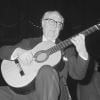
The South Bay Guitar Society is admired for its history of presenting outstanding emerging artists in concert. In that tradition, its audience had the distinct pleasure of hearing Chinese guitarist Hao Yang in a virtuosic recital of pervasive musicianship and interpretive flair on April 6 at St. Francis Episcopal Church in San Jose.
In music by J.S. Bach, Isaac Albéniz, and Mario Castelnuovo-Tedesco, Yang made exquisite use of the guitar’s wide palette of colors to highlight the distinct emotional world of each work. But it was her performance of two seldom-played masterworks, Music of Memory by Nicholas Maw and Air varié de l’opera de Bellini by Giulio Regondi, that made the evening special.
Maw (1935–2009), one of the most highly regarded British composers of his generation, wrote his mercurial Music of Memory after being inspired by a performance of Benjamin Britten’s Nocturnal After John Dowland. Maw’s own large-scale work (over 20 minutes in length) is a series of meditations on the Intermezzo from Felix Mendelssohn’s String Quartet No. 2, which Maw felt as a nostalgic “long-term memory of a golden age.” The music moves freely between the tonality of Mendelssohn and Maw’s often atonal meditations, with the tension between these harmonic styles providing the driving force. This is one of the most ambitious works in the guitar repertoire and calls for complete command of the instrument. Yang deftly projected the kaleidoscopic variety of moods and kept the structural arc absolutely clear in a masterful performance.
Regondi, who was born in Switzerland in 1822 and died in London in 1872, began his career as a child prodigy. A period of decline in guitar playing in the latter half of the 19th century caused his works, among the most demanding in the Romantic guitar literature, to be considered unplayable, though they’ve since received renewed interest. The composer himself played his variations on a melody from Vincenzo Bellini’s opera I Capuleti e i Montecchi in concerts during the 1850s, and the work was highly acclaimed by critics. The monumental style of the introduction appears to be strongly influenced by the opera fantasies of Franz Liszt. Yang’s performance was redolent of candelabra-lit Victorian parlors and blended unashamed sentiment with unabashed virtuosity.
Albéniz’s “Torre Bermeja” (The red tower) was written in 1888, when the composer was creating a distinctly Spanish classical music inspired by flamenco, the dance rhythms of Spain, and the colors of the guitar. Yang made the most of the idiomatic rapid arpeggios, pizzicato, rasgueados, and harmonics to create an engaging and exciting mood, and she shaped the very cante jondo melody with care.
The Toccata from Bach’s Keyboard Partita No. 6 in E Minor, BWV 830, is reminiscent of a French overture in its improvisatory outer sections framing an extended fugue. Bach unified the work by using motives from the outer sections as important elements within the fugue. Yang balanced the free outer sections and the strict rhythm of the fugue with passion and poise.

Castelnuovo-Tedesco’s Sonata “Omaggio a Boccherini,” Op. 77, is a four-movement work, written for Andrés Segovia in 1934, as the guitarist was striving to create a modern repertoire for the instrument. It is a large work with a mostly insouciant first movement, a lyrical and deeply felt second movement, a minuet and trio reminiscent of Luigi Boccherini, and a rondo finale whose virtuosic arpeggios are interrupted by heroic chordal passages. Yang projected the various moods with great skill. The audience responded with a standing ovation and was rewarded with an encore, the festive Joropo from Suite del Recuerdo by José Luis Merlin.
At many events, the South Bay Guitar Society admirably offers prelude performances by local students. This evening began with a lively and skillful performance by San Francisco Conservatory of Music pre-college guitarist Claire Okamoto, who played the Gavotte from Bach’s Violin Partita No. 3, Heitor Villa-Lobos’s Etude No. 10, and Jorge Morel’s “Danza Brasilera.”




